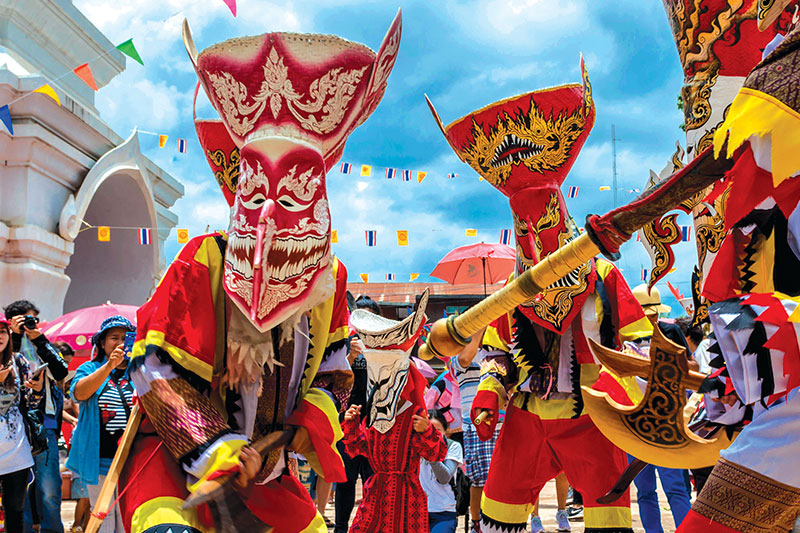
Where the Ghosts Come Out to Play
Spooky meets spectacular when the Phi Ta Khon festival haunts the streets of Dan Sai
Words: Sarita Urupongsa
The word “ghost” usually triggers fear and a sense of dread. But in the district of Dan Sai in Loei province, ghosts are surprisingly associated with colourful festivities and unlimited fun.
Since ancient times, local people have believed in the story of Phi Ta Khon, which means the “ghost that follows people”. The legend derives from the story of the Buddha’s past life as Vessantara, who was accompanied by protective spirits when he decided to leave the forest. This ancient folklore is brought to life by the Thai art of Khon (masked dance) to create the annual Phi Ta Khon Festival, blending local beliefs, merriment, and auspicious rites into one exuberant celebration.
Festivalgoers wear long masks and costumes richly decorated with either frightening or creative designs. Phi Ta Khon usually takes place in July as part of Bun Luang, a Buddhist festival of merit-making for spirits believed to protect the community.
This festival consists of three auspicious events, beginning with Boon Phawet Day where villagers march with a statue of Lord Buddha to the bank of the Mun River. Having asked for the water spirit’s protection, they retrieve the statue from the river before parading with it to Phon Chai Temple where the ceremony ends with lively music and the joyous Phi Ta Khon dance.
The second day is marked by the parade of Vessantara, also known as the Phi Ta Khon parade. Revellers wearing colourful ghost masks chant and dance their way along the streets in a ritual to invite good crop-growing weather. The parade winds from Dan Sai District Office to Phon Chai Temple. Visitors can expect a huge crowd as Phi Ta Khon troupes from districts far and wide gather to show off their costumes and dance moves.
The final day, Bunsamha, is taken up by prayers for forgiveness and good fortune. Sweet alms are also given to monks to ward off bad luck and bring prosperity to the town. The day ends with festivalgoers paying homage to the temple’s sacred Buddha statue and listening to the ancient Mahachati sermon.
However, the star of the festival is Phi Ta Khon, which comes in two sizes: big and small. The former consists of giant male and female effigies standing 3 metres tall. Only one family is permitted to craft the large Phi Ta Khon, using skills that have been passed down from generation to generation. The small Phi Ta Khon are more common and open to everyone.
The fun also lies in making the Phi Ta Khon masks. They are handcrafted from locally sourced materials, starting with coconut husks soaked overnight and then tied to a curved container to mould the face mask. After drying in the sun, the masks are trimmed and shaped. The top decoration is traditionally made from a woven sticky-rice steamer, symbolising the people’s gratitude for rice. These raw materials can be improvised, but one essential item is the ball or “galaeng” to alert the crowd that the Phi Ta Khon troupe is on its way.
Today, around 50 groups showcase distinct Phi Ta Khon styles, reflecting each community’s unique culture. The festival not only symbolises a long-cherished cultural heritage but also strengthens the bonds within local communities. It celebrates Dan Sai’s historic roots and cultivates this sense of belonging for future generations.
Art and culture lovers can explore deeper by visiting the collection of Phi Ta Khon masks at the Phon Chai Temple museum.
This year’s Phi Ta Khon Festival will take place in Dan Sai, Loei province from July 7-9.
